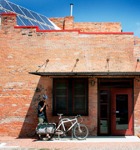The Scene
Montana is a place of tawny high plains that roll out below an endless blue sky speckled with white clouds. For hundreds of miles the only hints of human settlement are barbwire transections delineating the heavily trodden routes of cattle drivers. A man stands at the door to a saloon on the bad side of town in Billings, the state’s largest city. No, he’s not a cowboy. His name is Randy Hafer, an atypical architectural practitioner and scholar with degrees from Stanford and Yale, and he figured out how to resuscitate an abandoned 1890s brick tavern as a net-zero studio showpiece.

With its original storefront design, the Klos Building is part of the Billings Old Town Historic District. The plaque on the front, made from local Montana limestone, states that the building is also LEED Platinum certified.
The Setup
Using his own unique alchemy, Hafer blends philosophies of preservation and sustainability to solve problem projects in difficult environments. “The Klos Saloon was an old, worn-out, misused building,” Hafer says. “We picked a gnarly old structure and converted it to a state-of-the-art, high-performance building. You could have polled 100 people in town, and 100 people would have said ‘tear it down.’ We were able to do this conversion spending less … than if we tore it down and built a new one.” And since the building was to be the new home for his own firm, High Plains Architects, Hafer was able to push the envelope on what he wanted to do.

The studio's new conference room uses an abundance of salvaged materials from other projects around Billings, MT, including the numbered transoms, bead-board wainscot, and solid oak doors. Operable, double hung windows combine with operable awning windows in the front and operable skylights to create a natural “stack” effect.
The Strategy
With temperatures ranging from -49 to 112 degrees Fahrenheit and a dry climate producing less than 15 inches of rain each year, residents of Billings have learned to cope with extremes and make do with what they have. “This part of the world tends to be pretty frugal,” Hafer says. “People are used to taking care of themselves. We considered this a move up in the world from a warehouse across the street to a saloon that didn’t have a floor in it. Basically we started with a brick tube.”

The kitchen nook of the Klos Building demonstrates the use of rapidly renewable wheatboard and Dakota burl (made from sunflower seed shells) and also features a Paperstone countertop (made from pressurized paper).
BY THE NUMBERS
0
The number of gallons used from the city water utility since the rainwater collection system was connected to the Klos Building in October 2008
65
The percentage the building saves on its energy utilities when compared with a new building constructed to energy code
21
The percentage of the structure’s material that came from salvaged sources
What Hafer’s firm achieved was an off-the-grid rainwater collection system for all the Klos Building’s water needs, an electrical system with 30 percent of its power produced on-site through photovoltaic panels and the rest offsite through other renewable energy sources, and a stack-ventilation design supplying nearly 100 percent of the building’s cooling. “This building symbolizes taking advantage of all the available resources,” says Nash Emrich, a LEED AP and staff member at High Plains Architects. “We used a lot of salvaged and reclaimed materials in finishing out the building: headboard, old doors, and transoms salvaged from other projects and columns taken from the old baseball field. This exemplifies how you exist sustainably by using things for their full life.”
Using an existing structure, though, made the optimization of daylighting and natural ventilation more challenging. High Plains Architects’ Ed Gulick, who holds a master’s degree in architecture from Yale, says, “The building is situated on the original street grid in Billings to align with the railroad tracks, so it’s about 35 degrees off the cardinal directions. We were able to bring daylight into the building with a rooftop monitor oriented so the long dimension is on an east-west axis. The south-facing roof of the monitor is where we placed our photovoltaic panels. The north face of the monitor is where we introduce daylight into the building. The monitor created this parallelogram cut out in the middle of the building.”
With two rows of skylights operated remotely, and with the placement of operable windows in the storefront and conference room at ground level, cooling is achieved through convection from air rising through the building. “Without a breeze, stack ventilation is much more effective than cross ventilation,” Gulick says. “The success of this is so dramatic that we are building it into everything we are doing now.”

